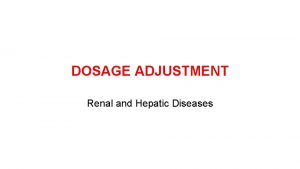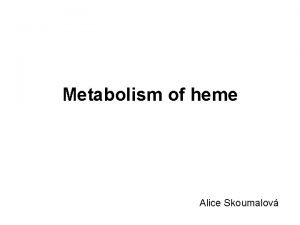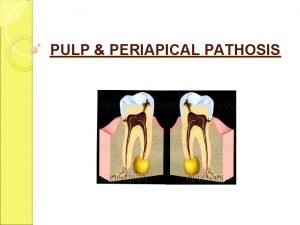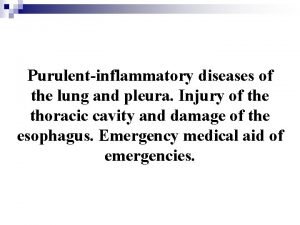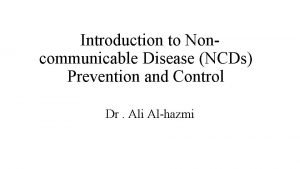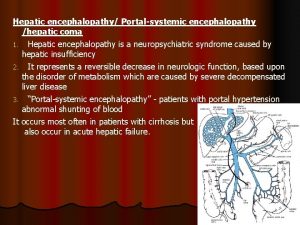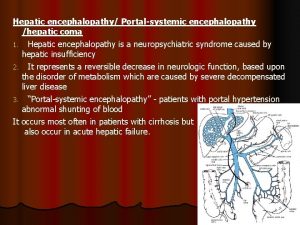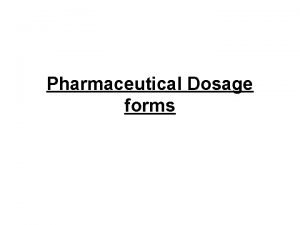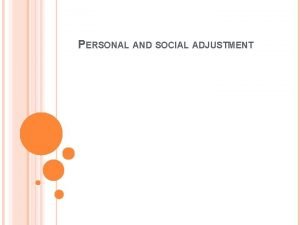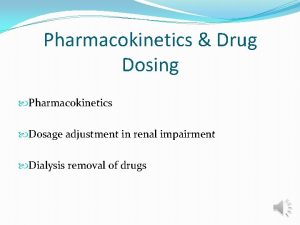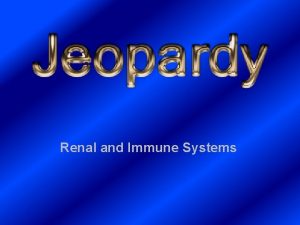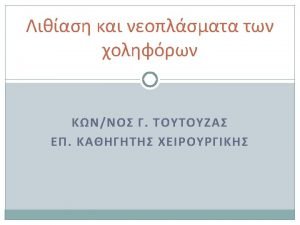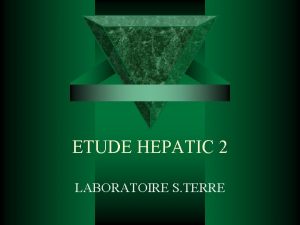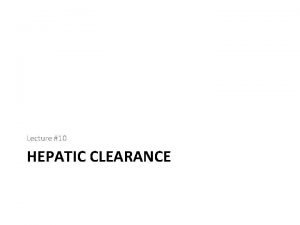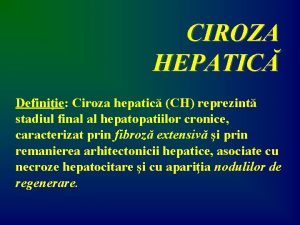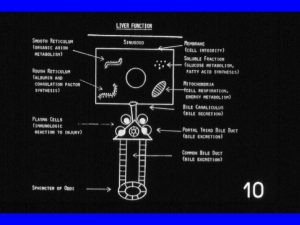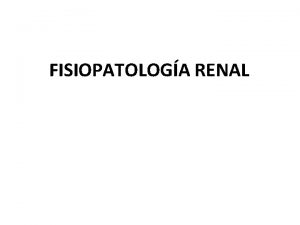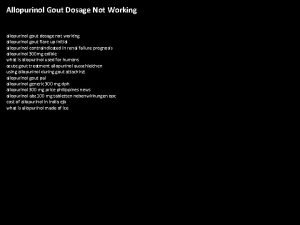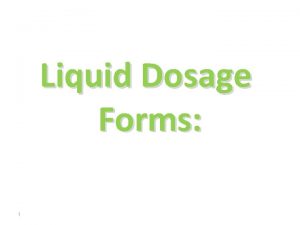DOSAGE ADJUSTMENT Renal and Hepatic Diseases INFLUENCE OF
































- Slides: 32

DOSAGE ADJUSTMENT Renal and Hepatic Diseases

INFLUENCE OF DISEASE ON PHARMACOKINETICS - RENAL MEASURING RENAL FUNCTION A. Glomerular filtration rate (GFR) 1. determined from excretion rate of a freely filtered substance* (e. g. , inulin) and its concentration in plasma: GFR = (Cur) (Qur) / Cp where Cur is concentration in urine, Qur is urine flow rate, and Cp is concentration in plasma. * must be a substance not actively secreted or reabsorbed.

2. we usually use creatinine clearance (Clcr) as an index of GFR a. creatinine is an easily measured endogenous substance b. creatinine rises in proportion to decreases in GFR



c. Assumptions* of using Clcr as an accurate estimate of GFR: 1. ) daily anabolic production of creatine by the liver is constant 2. ) daily anabolic conversion of creatine to creatinine in striated muscle is constant 3. ) creatinine is only removed from the serum by filtration 4. ) measurement is accurate 5. ) urine collection is complete * all of these assumptions are invalid at least part of the time

d. normal creatinine clearance values healthy young male: 125 ml/min/1. 73 m 2 healthy young female: 115 ml/min/1. 73 m 2 by 60 years of age, reduced to about 70% of young adult

Estimation of Creatinine Clearance Several investigators have developed mathematical relationships to estimate CLcr when urine is unavailable. These factors include age, gender, weight, and serum creatinine concentration. Perhaps the most widely used of these estimators is the one developed by Cockcroft and Gault, which identified age and body mass as factors that significantly improved the estimate of CLcr.


Estimation of Creatinine Clearance Cockcroft and Gault Age: years, Weight: Kg, Sr. Cr: mg/dl

The Cockcroft-Gault method should only be used in patients 1) ≥ 18 years old, 2) actual weight within (20 -30)% of their ideal body weight (IBW) and 3) stable serum creatinine concentrations. Adjusted Body Weight (Adj. BW)


INFLUENCE OF RENAL DISEASE ON KINETIC PARAMETERS A. Absorption 1) Data are somewhat contradictory and therefore inconclusive 2. Difficult to detect a change, as alterations in other variables such as protein binding, apparent volume of distribution, metabolism, and/or renal clearance could all mask impact of renal disease on oral absorption.

Apparent Volume of Distribution at Steady-State (Vdss)



When to adjust 1) More Than 30 % of the drug is excreted in urine AND 1) The decrease in renal function is more than 30 %


Case 1 Lincomycin is given in a dose of 600 mg every 6 hours to a 75 -kg normal patient. What doses would be used (Renal clearance for licomycin = 60 % and the normal half-life is 4. 6 hours) 1) In complete renal shutdown? 2) When Clcr is 10 ml/min?




Case 2 The maintenance dose of gentamicin is 80 mg every 6 hours for a patient with normal renal function. Calculate the maintenance dose for a uremic patient with creatinine clearance of 20 ml/min?

Case 3 Using the method of Cockroft and Gault, calculate the creatinine clearance for a woman (38 years old, 62 kg) whose serum creatinine is 1. 8 mg/dl. (Answer is 41. 5 ml/min) Case 4 Would you adjust the dose of cephamandole, an antibiotic which is 98 % excreted unchanged in urine, for the patient in case 3? Why?

Case Study: Calculate an appropriate dosing regimen for the following male patient (Xo, , XL); age = 56 years, weight = 62 kg. Normally this drug has a half-life of 3 hours and 70% excreted in urine. Apparent volume of distribution is calculated as 0. 28 L/Kg. Develop a dosing regimen to keep the peak concentration close to but below 6 µg/ml and the trough concentration below but close to 1. 0 µg/ml 1) Clcr is normal 2) Clcr is 40 % of normal.

A patient is using three drugs, A, B and C. Drug A is 100% eliminated by the kidneys. Drug B is 70% eliminated by the kidneys. Drug C is entirely eliminated via hepatic metabolism. The patient has suffered from acute renal failure leading to Reduction in the creatinine clearance by 40% provided that the elimination half-lives for the three drugs are 6, 9 and 4 hours for drug A, B and C respectively. Find out the followings: 1) Changes in the elimination half-lives of the three drug. 2) The new maintenance doses that will produce the same average plasma concentration produced by the original doses, previous maintenance doses are: for drug A 10 mg/day for drug B 30 mg/day for drug C 50 mg/day

Case 1) A 60 yr, 72 kg male admitted to the hospital because of severe pneumonia. His serum creatinine was 2. 0 mg/dl. Estimate the creatinine clearance for this patient. 30 ml/min 40 ml/min 120 ml/min 60 ml/min 27

The average renal clearance of tetracycline is 3. 5 L/hr, while its average total body clearance is 7 L/hr. What is the fraction of tetracycline bioavailable dose excreted unchanged in urine ? 0. 10 0. 25 0. 50 0. 80 28

Tetracycline is a broad spectrum antibiotic that is used to treat a variety of infections. If the average dose of tetracycline in adult patients with normal kidney function is 500 mg every 8 hours, what will be the dose required in a patient with only 20% of the normal kidney function if 50% of tetracycline dose is excreted unchanged in urine ? 250 mg q 8 hr 300 mg q 8 hr 500 mg q 8 hr 29

Ranitidine is an H 2 -receptor antagonist used in the treatment of peptic ulcer. After administration of the average dose of ranitidine in patients with normal kidney function (150 mg q 12 hr), 70% of the dose is excreted unchanged in urine. What will be the ranitidine dose required in a patient with only 30% of normal kidney function ? 30 mg q 12 hr 45 mg q 12 hr 100 mg q 12 hr 75 mg q 12 hr 30


 Maintenance dose formula
Maintenance dose formula Res extra commercium
Res extra commercium Sindrome nefrótica
Sindrome nefrótica Distinguish between renal corpuscle and renal tubule
Distinguish between renal corpuscle and renal tubule Dpp-4 inhibitors side effects
Dpp-4 inhibitors side effects Hepatic and posthepatic jaundice
Hepatic and posthepatic jaundice Hepatic and posthepatic jaundice
Hepatic and posthepatic jaundice Types of jaundice
Types of jaundice Lifestyle modern
Lifestyle modern Is athlete's foot communicable or noncommunicable
Is athlete's foot communicable or noncommunicable Section 19-3 diseases caused by bacteria and viruses
Section 19-3 diseases caused by bacteria and viruses Chapter 8 skin disorders and diseases
Chapter 8 skin disorders and diseases Chapter 6 musculoskeletal system diseases and disorders
Chapter 6 musculoskeletal system diseases and disorders Chapter 24 sexually transmitted diseases and hiv/aids
Chapter 24 sexually transmitted diseases and hiv/aids Chapter 22 genetics and genetically linked diseases
Chapter 22 genetics and genetically linked diseases Chapter 21 mental health diseases and disorders
Chapter 21 mental health diseases and disorders Chapter 17 reproductive system diseases and disorders
Chapter 17 reproductive system diseases and disorders Chapter 15 nervous system diseases and disorders
Chapter 15 nervous system diseases and disorders What conditions do fungal organisms favor for growth
What conditions do fungal organisms favor for growth Seborrheic keratoses
Seborrheic keratoses Chapter 10 nail disorders and diseases
Chapter 10 nail disorders and diseases Certain infectious and parasitic diseases
Certain infectious and parasitic diseases Cardiovascular system diseases and disorders chapter 8
Cardiovascular system diseases and disorders chapter 8 Pulp and periapical diseases
Pulp and periapical diseases Milady chapter 8 skin disorders and diseases
Milady chapter 8 skin disorders and diseases Venn diagram of communicable and non-communicable diseases
Venn diagram of communicable and non-communicable diseases Purulent diseases of lungs and pleura
Purulent diseases of lungs and pleura Tronsmo plant pathology and plant diseases download
Tronsmo plant pathology and plant diseases download Tronsmo plant pathology and plant diseases download
Tronsmo plant pathology and plant diseases download Albugo eye
Albugo eye Difference between communicable and noncommunicable
Difference between communicable and noncommunicable Function of vitamins
Function of vitamins Myth and fallacies about non-communicable diseases
Myth and fallacies about non-communicable diseases
